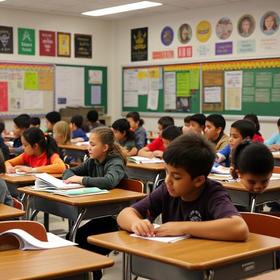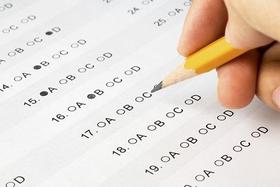Top Rankings
Shaler Area School District ranks among the top 20% of public school district in Pennsylvania for:
Category
Attribute
Graduation Rate
Highest graduation rate (Top 5%)
Community Size
Largest student body (number of students) (Top 1%)
For the 2025-26 school year, there are 5 public elementary schools serving 2,001 students in Shaler Area School District. This district's average elementary testing ranking is 8/10, which is in the top 30% of public elementary schools in Pennsylvania.
Public Elementary Schools in Shaler Area School District have an average math proficiency score of 52% (versus the Pennsylvania public elementary school average of 39%), and reading proficiency score of 64% (versus the 54% statewide average).
Minority enrollment is 12% of the student body (majority Hispanic and Black), which is less than the Pennsylvania public elementary school average of 42% (majority Hispanic and Black).
Overview
This School District
This State (PA)
# Schools
7 Schools
2,145 Schools
# Students
3,756 Students
1,108,977 Students
# Teachers
317 Teachers
82,943 Teachers
Student-Teacher Ratio
12:1
12:1
Student By Grade
District Rank
Shaler Area School District, which is ranked within the top 30% of all 678 school districts in Pennsylvania (based off of combined math and reading proficiency testing data) for the 2022-2023 school year.
The school district's graduation rate of 97% has increased from 92% over five school years.
Overall District Rank
#169 out of 685 school districts
(Top 30%)
(Top 30%)
Math Test Scores (% Proficient)
45%
38%
Reading/Language Arts Test Scores (% Proficient)
64%
55%
Science Test Scores (% Proficient)
60%
57%
Graduation Rate
97%
87%
Students by Ethnicity:
Diversity Score
0.22
0.61
% American Indian
n/a
n/a
% Asian
1%
5%
% Hispanic
3%
16%
% Black
2%
15%
% White
89%
58%
% Hawaiian
n/a
n/a
% Two or more races
5%
6%
All Ethnic Groups
District Revenue and Spending
The revenue/student of $23,783 is higher than the state median of $23,696. The school district revenue/student has stayed relatively flat over four school years.
The school district's spending/student of $23,949 is higher than the state median of $23,119. The school district spending/student has stayed relatively flat over four school years.
Total Revenue
$89 MM
$39,541 MM
Spending
$90 MM
$38,578 MM
Revenue / Student
$23,783
$23,696
Spending / Student
$23,949
$23,119
Best Shaler Area School District Public Elementary Schools (2025-26)
School
(Math and Reading Proficiency)
(Math and Reading Proficiency)
Location
Quick Facts
Rank: #11.
Marzolf Primary School
(Math: 75-79% | Reading: 80-84%)
Rank:
Rank:
10/
Top 5%10
101 Marzolf Road Ext
Pittsburgh, PA 15209
(412) 492-1200
Pittsburgh, PA 15209
(412) 492-1200
Gr: K-3 | 297 students Student-teacher ratio: 11:1 Minority enrollment: 12%
Rank: #22.
Burchfield Primary School
(Math: 85-89% | Reading: 75-79%)
Rank:
Rank:
10/
Top 5%10
1500 Burchfield Rd
Allison Park, PA 15101
(412) 492-1200
Allison Park, PA 15101
(412) 492-1200
Gr: K-3 | 336 students Student-teacher ratio: 13:1 Minority enrollment: 9%
Rank: #33.
Scott Primary School
(Math: 80-84% | Reading: 70-74%)
Rank:
Rank:
10/
Top 10%10
705 Scott Ave
Glenshaw, PA 15116
(412) 492-1200
Glenshaw, PA 15116
(412) 492-1200
Gr: K-3 | 378 students Student-teacher ratio: 15:1 Minority enrollment: 13%
Rank: #44.
Reserve Primary School
(Math: 80-89% | Reading: 60-69%)
Rank:
Rank:
9/
Top 20%10
2107 Lonsdale St
Pittsburgh, PA 15212
(412) 492-1200
Pittsburgh, PA 15212
(412) 492-1200
Gr: K-3 | 113 students Student-teacher ratio: 9:1 Minority enrollment: 13%
Rank: #55.
Shaler Area Elementary School
(Math: 42% | Reading: 60%)
Rank:
Rank:
6/
Top 50%10
705 Scott Avenue
Glenshaw, PA 15116
(412) 491-1200
Glenshaw, PA 15116
(412) 491-1200
Gr: 4-6 | 877 students Student-teacher ratio: 13:1 Minority enrollment: 12%
Recent Articles

How Public Schools Support Students on Free / Reduced-Lunch Programs
Explore how U.S. public schools support students eligible for free or reduced-price lunch through nutrition, academic, and wraparound services in 2025.

Hidden Costs of Public Schools: Fees, Supplies & Extras
Explore the hidden costs in public schools—fees, supplies, extracurriculars—and how parents can plan for them in 2025.

Public School Funding 2025: What Families Should Know
Essential insights on public school funding in 2025—how it works, what’s changing, and what families should know to stay ahead.





